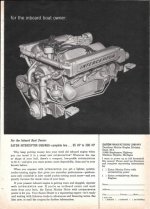High RPMs for extended times, 3000-4000 RPM is typical. The Y-block is stated in the owner's manual and engine sticker to prop for 4000 RPM max engine speed at full throttle. The small block is listed a bit higher, I think 4400 RPM. Think about your small block having the throttle pinned wide open for hours at a time turning 4000 RPM, that part throttle 3000 RPM highway cruise is no big deal.
I think the smaller pulley is to try and keep the raw water pump RPM down. The pump is located below the crankshaft (so it doesn't have to lift water) and a larger pulley to slow it down would make the pulley the lowest point on the engine. So both pulleys (crankshaft and waterpump) are abnormally small. Alternator does a great job of low RPM charging compared to what old generators could do.
As for the charging system, that is another oddity. This is a factory alternator. 1960 was the first year an alternator was standard equipment in a Plymouth Valiant, This is a 1963 boat motor. Early mustangs were still generators. The alternator from Ford was introduced in 65 or 66. The one on this boat engine is a mystery. The only markings are "Interceptor" which the name on the line of marine engines. Sort of reminds me of early Motorola alternators. Strange stuff like the charge wire is routed through the voltage regulator.












